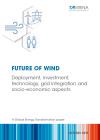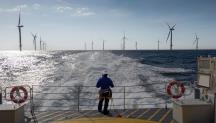

-
-
IRENA (2019), Future of wind: Deployment, investment, technology, grid integration and socio-economic aspects (A Global Energy Transformation paper), International Renewable Energy Agency, Abu Dhabi.
Copied
/-/media/Files/IRENA/Agency/Publication/2019/Oct/IRENA_Future_of_wind_2019.pdf
Copied
Future of wind
Newsletter
Deployment, investment, technology, grid integration and socio-economic aspects
Reducing carbon dioxide (CO2) emissions is at the heart of the world’s accelerating shift from climate-damaging fossil fuels towards clean, renewable forms of energy. In addition to fulfilling the Paris Agreement, renewables are crucial to reduce air pollution, improve health and well-being, and provide affordable energy access worldwide. Wind energy forms an important part of this key environmental and energy solution.
Fully unlocking wind potential for power generation will be crucial for the success of the global energy transformation. This paper from the International Renewable Energy Agency (IRENA) presents options to speed up the deployment of wind power, both onshore and offshore, over the period until 2050.
See the executive summary in English or Chinese (中文).
The analysis follows the REmap Case outlined in IRENA’s Global Energy Transformation roadmap, which highlights ways to step up the energy transformation over the next three decades in contrast to current plans.
Specifically, the paper highlights the growth needed in wind power to achieve Paris climate goals. It also offers insights on cost-reduction opportunities, technology trends and the need to prepare electricity grids for rising shares of wind power.
Among the findings:
- Accelerated wind power deployment, coupled with increased electrification, could deliver one-quarter (or nearly 6.3 gigatonnes) of the annual CO₂ emission reductions needed by 2050.
- Wind power could cover more than one-third of global power needs (35%), becoming the world’s foremost generation source.
- To fulfil this aim, the world’s installed wind power capacity must reach 6 000 gigawatts – over 10 times the current level – by 2050. This would include 5 000 GW of onshore wind and 1 000 GW of offshore wind.
- Asia is poised to become the world’s dominant wind market, accounting for more than 50% of onshore and 60% of offshore wind installations by 2050. Asia’s onshore wind capacity could grow from 230 GW in 2018 to over 2 600 GW by 2050.
- Increasing economies of scale, more competitive supply chains and further technological improvements should reduce electricity costs from onshore wind to less than three cents (USD 0.03) per kilowatt hour by 2050, IRENA’s analysis shows. Prices from offshore wind are expected to fall below seven cents, also towards the lower end of cost range for power generation based on fossil fuels.
- To fulfil climate goals and help to contain the rise of global temperatures, annual investment in onshore wind needs to triple from USD 67 billion in 2018 to USD 211 billion globally in 2050. Annual investment in offshore wind would have to more than quintuple, from USD 19 billion in 2018 to USD 100 billion in 2050.
- The resulting transformation could bring socio-economic benefits. The global wind industry drives the creation of new jobs and could employ over six million people worldwide by 2050, compared to about one million currently.




